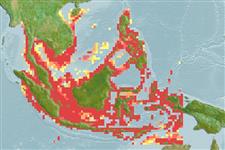Environment: milieu / climate zone / depth range / distribution range
Ecología
marino asociado a arrecife; rango de profundidad 5 - 50 m (Ref. 90102). Tropical; 20°N - 12°S, 97°E - 135°E (Ref. 3810)
Western Central Pacific: Philippines, South China Sea, Singapore, and Indonesia.
Tamaño / Peso / Age
Maturity: Lm ? range ? - ? cm
Max length : 18.0 cm SL macho / no sexado; (Ref. 48635); common length : 15.0 cm SL macho / no sexado; (Ref. 3810)
Espinas dorsales (total): 10; Radios blandos dorsales (total): 9; Espinas anales 3; Radios blandos anales: 7. Head scales reaching forward to between level of anterior margin of eyes and posterior nostrils. Suborbital naked. Lower limb of preopercle naked. Pelvic fins short, not reaching level of anus. Axillary scale present. Color: Pale brownish on back, lower part of body whitish. Presence of two bluish stripes across snout, first from middle of eye to tip of snout, second from upper lip to lower margin of eye. Top of snout dusky.
Found in silty coastal bays to deep muddy habitats offshore. Swims on open substrate adjacent to reefs, usually in small aggregations. Often with large bottom feeders such as stingrays to catch disturbed prey (Ref. 48635). Juveniles found close to reefs. Feeds on small crustaceans. Also taken by bamboo stake trap in Thailand. Used also in fish balls, fried and as duck food. Not much appreciated for food, and low priced.
Life cycle and mating behavior
Madurez | Reproducción | Puesta | Huevos | Fecundidad | Larva
Russell, B.C., 1990. FAO Species Catalogue. Vol. 12. Nemipterid fishes of the world. (Threadfin breams, whiptail breams, monocle breams, dwarf monocle breams, and coral breams). Family Nemipteridae. An annotated and illustrated catalogue of nemipterid species known to date. FAO Fish. Synop. 125(12):149p. Rome: FAO. (Ref. 3810)
IUCN Red List Status (Ref. 130435)
Threat to humans
Harmless
Human uses
Pesquerías: escaso valor comercial
Más información
Nombres comunesSinónimosMetabolismoDespredadoresEcotoxicologíaReproducciónMadurezPuestaAgregación para la puestaFecundidadHuevosEgg development
ReferenciasAcuiculturaPerfil de acuiculturaRazasGenéticaElectrophoresesheritabilidadEnfermedadesProcesamientoNutrientsMass conversion
ColaboradoresImágenesStamps, Coins Misc.SonidosCiguateraVelocidadTipo de nataciónSuperficie branquialOtolitosCerebrosVisión
Herramientas
Special reports
Download XML
Fuentes de Internet
Estimates based on models
Preferred temperature (Ref.
123201): 27.7 - 29.2, mean 28.7 °C (based on 588 cells).
Phylogenetic diversity index (Ref.
82804): PD
50 = 0.5002 [Uniqueness, from 0.5 = low to 2.0 = high].
Bayesian length-weight: a=0.01349 (0.00767 - 0.02371), b=2.98 (2.83 - 3.13), in cm total length, based on LWR estimates for this species & (Sub)family-body (Ref.
93245).
Nivel trófico (Ref.
69278): 3.5 ±0.50 se; based on food items.
Resiliencia (Ref.
120179): Alto, población duplicada en un tiempo mínimo inferior a 15 meses (Preliminary K or Fecundity.).
Fishing Vulnerability (Ref.
59153): Low vulnerability (12 of 100).
Nutrients (Ref.
124155): Calcium = 75.3 [43.9, 154.2] mg/100g; Iron = 0.729 [0.357, 1.698] mg/100g; Protein = 18.9 [17.0, 20.6] %; Omega3 = 0.163 [0.096, 0.273] g/100g; Selenium = 27.5 [16.4, 49.9] μg/100g; VitaminA = 92.3 [26.3, 276.0] μg/100g; Zinc = 1.46 [1.00, 2.13] mg/100g (wet weight);
